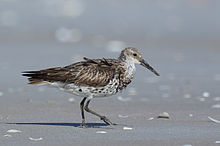Eighty Mile Beach
| Designations | |
|---|---|
| Official name | Eighty-mile Beach |
| Designated | 7 June 1990 |
| Reference no. | 480[1] |

Eighty Mile Beach also spelled Eighty-mile Beach or 80-mile Beach, and formerly called 90-mile Beach, lies along the north-west coast of Western Australia about half-way between the towns of Broome and Port Hedland. It is a beach some 220 kilometres (140 mi) in length,[2] forming the coastline where the Great Sandy Desert approaches the Indian Ocean. It is one of the most important sites for migratory shorebirds, or waders, in Australia, and is recognised as a wetland of international importance under the Ramsar Convention on Wetlands.[2]
History
Traditional ownership and usage





The southern section of Eighty Mile Beach is part of the traditional territory of the
Traditional ownership of the northern part of Eighty Mile Beach, within the vicinity of the Anna Plains pastoral lease, is shared between the Nyangumarta People and the Karajarri (or Garadjari) People. The two groups filed overlapping native title determination applications over the area, which were determined together on 25 May 2012.[4] The judgement of the Court was delivered on country at Talgarno, a former military site within the Anna Plains pastoral lease.
In the Karajarri language, Eighty Mile Beach is called Wender, meaning "a creaking noise", with reference to the sound of walking through dry sand. Many
Name
The beach was known as 90-mile beach until 1946 when the name was changed to avoid confusion with Ninety Mile Beach, Victoria.[5]
Military use
The Talgarno military base, east of Anna Plains homestead, was important in the post-
Shorebird research
Because of its importance for shorebirds, Eighty Mile Beach is classified as an
Description
Geography

Eighty Mile Beach lies in the
Climate
The climate is semi-arid monsoonal with a hot wet summer and a warm dry winter. Median and mean annual rainfall are 327 mm and 341 mm respectively, with annual evaporation about 3500 mm. There is much variability in rainfall, with significant variation between years as well as the period when the bulk of the rain falls; much is contributed by tropical cyclones, especially from January to March.[2]
Ramsar site
Some 1,750 square kilometres (680 sq mi) of the beach and adjoining land, as well as the Mandora Marsh, was designated Ramsar Site 480 on 7 June 1990.[2][8]
Eighty Mile Beach



Flora
Along the beach, the primary dunes are stabilised by green birdflower and beach spinifex. Secondary parallel, calcareous dune ridges and swales commonly feature scattered dune wattle. Significant grasses include Whiteochloa airoides and the local endemic Triodia epactia, a resinous hummock-forming species. Inland grasslands have been strongly modified by intensive cattle grazing and are dominated by introduced buffel grass and birdwood grass.[2]
Fauna
The principal conservation value of Eighty Mile Beach lies in the presence of very large numbers of shorebirds, for which it is one of the most important non-breeding and migratory stop-over areas in the
Mandora Marsh
Mandora Marsh, also known as the Mandora Salt Marsh, is a diverse wetland complex based on a palaeo-river system. It lies on Mandora Station, with the western end some 30 km from Eighty Mile Beach, beginning on the inland side of the Great Northern Highway, at the western edge of the Great Sandy Desert, in which bioregion it lies. Although it is included in the Eighty Mile Beach Ramsar Site, its environmental values are somewhat different.
Tourism and access
Eighty Mile Beach is subject to a relatively low but increasing amount of
References
Notes
- ^ "Eighty-mile Beach". Ramsar Sites Information Service. Retrieved 25 April 2018.
- ^ a b c d e f g h i j Information Sheet on Ramsar Wetlands.
- ^ Hunter v State of Western Australia [2009] FCA 654, Federal Court (Australia).
- ^ Hunter v State of Western Australia [2012] FCA 690, Federal Court (Australia).
- ^ "Britannica". Retrieved 7 March 2023.
- ^ "IBA: Eighty Mile Beach". Birdata. Birds Australia. Archived from the original on 6 July 2011. Retrieved 20 June 2011.
- ^ Minton (2006).
- ^ Annotated Ramsar List.
Sources
- Livesey, N. J. G. (1993) Eighty-Mile Beach Area : supporting documentation for inclusion on the register of the National Estate : report to the Australian Heritage Commission and the Heritage Council of Western Australia, August 1993 Murdoch, W.A. : Murdoch University. NEDP documentation ; no. 3:93
- Minton, Clive (2006). "The history of wader studies in north-west Australia". Stilt. 50: 224–234.
- Stewart, R. R. (2005) Biophysical resource assessment of the Canning Coast, WA, including Roebuck Bay, Lagrange Bay and Eighty Mile Beach other authors – K. Fitzgerald and P. Kindleysides. Fremantle, W.A. : Dept. of Conservation and Land Management, Marine Conservation Branch,'"Data report: MRI/CAN,EMB/RBL,EMB-66/2005"
External links
![]() Media related to Eighty Mile Beach at Wikimedia Commons
Media related to Eighty Mile Beach at Wikimedia Commons
- "The Annotated Ramsar List: Australia". The Ramsar Convention on Wetlands. 4 January 2000. Archived from the original on 19 September 2011. Retrieved 14 April 2010.
- "Information Sheet on Ramsar Wetlands: Eighty-mile Beach". Department of Conservation and Land Management, Western Australia. November 2003. Archived from the original on 13 March 2011. Retrieved 14 April 2010.
